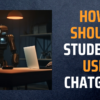Hello everyone! I’m delighted you’ve joined me today to explore the captivating world of artificial intelligence. We’re putting the spotlight on OpenAI’s incredible language model, ChatGPT. I’ve spent countless hours navigating this powerful tool and can’t wait to share my discoveries with you!
ChatGPT has sparked a revolution in our interaction with AI. Whether you want to create a captivating story, get responses to tricky queries, or even take a swing at learning a new language, ChatGPT is your go-to companion. However, are you truly making the most out of it?
Whether you’re a rookie or have been using ChatGPT for a while and feel there’s more to unearth, you’re in the right place. I’ve put together my Top 10 Tips and Tricks for Using ChatGPT to ensure you get the most enriching and engaging experience.
The Art of Crafting Instructions
ChatGPT, like all language model AIs, is a masterful responder to your queries or instructions.
- Specificity is Key: To get detailed and pointed responses, it’s important to be explicit in your instructions.
- Set the Tone: If you want a specific style or tone in the output, make sure to mention that upfront.
For instance, instead of simply stating “Write a blog post”, direct the AI by saying “Write a blog post about climate change, using an informative and engaging tone, and specifically targeting teenagers.”
The Power of System Instructions
- System level instructions are a game-changer that often get overlooked. Use these to navigate the AI’s behavior. Want the AI to think in a step-by-step manner and explain its reasoning? Use a command like: “You are an AI that thinks step-by-step and carefully explains your reasoning.”
Mastering Temperature Settings
ChatGPT’s temperature setting is a wonderful tool to adjust the output.
- Higher Temperature: Set a higher temperature (0.8 – 1.0) when you need random and creative outputs.
- Lower Temperature: Use a lower temperature (0.2 – 0.5) for focused and deterministic responses.
Understand Token Count
- It’s crucial to understand that ChatGPT operates within a token limit per interaction. A token can range from a single character to a word. If the response seems cut-off or insufficient, try shortening your input.
Utilize User Models
- User models let you customize ChatGPT to your specific needs, making it particularly helpful for recurring tasks. With a user model, you can train the AI to perform tasks in a way that best suits your preferences.
Explore the ‘Chat’ Format
- Engage with ChatGPT in a conversation format for a richer experience. This method allows you to guide the conversation back if the AI deviates from the intended topic.
Implement Reinforcement Learning from Human Feedback (RLHF)
- RLHF is a tool that allows you to provide feedback to ChatGPT, steering its responses in the desired direction. It’s a bit like training a pet; with consistent feedback, the AI can learn and improve.
Iterate Your Instructions
- If at first, you don’t get what you want, iterate and refine your instruction. Remember, each new interaction is a chance for the AI to learn and adapt.
Experiment with Multimodal Models
- These models can handle not only text but also images, offering a more diverse and interactive user experience.
Stay Updated
- OpenAI is continually working on enhancing and refining ChatGPT. Ensure you stay updated with the latest advancements to make the most of this AI tool.
Also read:
How to Integrate ChatGPT Into Microsoft Word
How to Draw Graphs, Charts and Diagrams in ChatGPT
How to Integrate ChatGPT Into Microsoft Word
How to Turn off Chat History in ChatGPT
FAQs
How can I make ChatGPT generate more creative or more focused responses?
You can control the randomness or creativity of ChatGPT’s responses by adjusting the “temperature” setting. Higher values (closer to 1.0) yield more creative and random responses, while lower values (closer to 0.2) produce more focused and deterministic responses.
I’m trying to generate a long piece of text, but the response gets cut off. Why is this happening?
This is due to the token limit per interaction set by OpenAI for ChatGPT. A token can be as short as one character or as long as one word. If your responses are getting cut off, consider shortening your input or breaking it down into smaller parts.
Can ChatGPT remember information from previous sessions?
As of my knowledge cutoff in September 2021, ChatGPT does not have the capability to remember or store personal data from session to session. It is designed this way to prioritize user privacy.
How do I guide the AI’s behavior during a conversation?
There are a couple of ways you can guide ChatGPT. First, you can use system level instructions. For instance, you can instruct the AI to “think step by step”. Additionally, you can use the chat format and provide ongoing directions to guide the conversation.
What is the best way to ask ChatGPT for detailed responses?
To get more detailed responses, be as specific as possible in your prompts. You could also ask the model to “think step-by-step” or to “elaborate” on its answers. This usually encourages a more in-depth response.
Can I use ChatGPT for creative writing or story generation?
Yes, you certainly can! ChatGPT can help generate creative text, including stories, poems, and scripts. You can guide the tone and genre of the story by providing detailed instructions in your prompts.
What does ‘temperature’ setting mean?
The ‘temperature’ setting in ChatGPT influences the randomness of the AI’s responses. A higher temperature will make the output more varied and creative, while a lower temperature makes it more focused and consistent.
Can I teach ChatGPT my preferences?
Yes, using a ‘user model’, you can guide ChatGPT to learn and adapt to your specific needs and preferences over time. However, please note that as of my last training data in September 2021, this feature may not be fully available and may have been updated.
Can I use ChatGPT to learn a new language?
Yes, ChatGPT can help with language learning. You can have conversations in the language you’re learning, ask it to translate sentences, or even use it to practice writing in your target language.
What are multimodal models?
Multimodal models can process and generate not just text, but also images, providing a more diverse and interactive user experience. As of my knowledge cutoff in September 2021, OpenAI was working on these models, so check for the latest updates.
Conclusion
In essence, the secret to a rewarding ChatGPT experience lies in effective communication. While ChatGPT is an advanced model, it’s not without its limitations. The beauty lies in its ability to learn and improve with your input. Journeying through the capabilities of ChatGPT is an exciting expedition. It’s like traversing through a land of discovery, with lots to learn and explore. However, it’s crucial to have patience, a creative mind, and a willingness to experiment.
I’ve found these tips and tricks instrumental in enhancing my ChatGPT experience, and I believe they’ll prove useful for you too. So dive in, experiment with these strategies and let me know about your experiences. Remember, the AI landscape is vast and continually evolving, but it needn’t be intimidating. Embrace it, explore it, and grow with it. As you deepen your understanding, you might develop your unique tips and tricks for using ChatGPT. If you do, I’d love to hear them!
As we conclude, I hope this guide has empowered you to delve deeper into your AI journey with ChatGPT. Just remember, every expert started at the beginning. Keep learning, keep experimenting, and most importantly, remember to enjoy the process!
Until we meet again, happy exploring!







